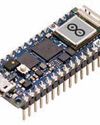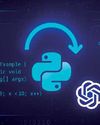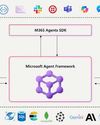Low-Code and No-Code Platforms: Get Ready for the Future
Open Source For You
|August 2024
Software development has received a boost with the emergence of low-code/no-code (LCNC) platforms that allow even those not initiated in coding to create applications in quick time. We take a look at some of the best LCNC platforms in the open source domain.

With skilled software developers in short supply, enterprises are turning to artificial intelligence (AI) and lowcode/no-code (LCNC) platforms to get their work done quickly while reducing development costs. Lowcode software development uses a platform that requires minimal coding to create software. Low-code platforms are suitable for rapid application development and automating business processes. No-code software development provides an interface with drag-and-drop functionality to develop applications from various templates and components of pre-programmed software. This helps to create an application without coding. Nocode platforms are suitable for small businesses and offer quick solutions.
Gartner predicts that by 2026, developers outside formal IT departments will account for at least 80% of the user base for low-code development tools, up from 60% in 2021. According to IDC, sales of nocode platforms will grow at an annual rate of 13.9% through 2026, with that of low-code platforms growing at 14.1% over the same period.
A market research study published by P&S Intelligence states that the global low-code market will witness a 31.1% CAGR between 2020 and 2030 to reach US$ 187 billion by 2030.
Key characteristics of LCNC platforms LCNC platforms enable developers to quickly build applications by leveraging a library of pre-built components, such as user interfaces, databases, and APIs. Check Figure 1 for the key characteristics of these platforms.
Some of the most common characteristics are:
Accelerated application development and a drag-and-drop interface, which allows creation of applications by using flow charts and other diagrams. These platforms democratise development as there is no need of experience and training to build effective custom apps.
Reusable code functionality, which saves time as users don’t need to re-create core components.
Denne historien er fra August 2024-utgaven av Open Source For You.
Abonner på Magzter GOLD for å få tilgang til tusenvis av kuraterte premiumhistorier og over 9000 magasiner og aviser.
Allerede abonnent? Logg på
FLERE HISTORIER FRA Open Source For You

Open Source For You
The Role of Open Source in Building Modern Data Infrastructure
It's no secret that open source is emerging as the backbone of modern data infrastructure. Here’s a list of the core open source technologies used to deploy this infrastructure, along with some real-world examples and a brief on why open source matters.
3 mins
December 2025

Open Source For You
The Whispering Machines: How Open Source is Bringing Intelligence to the Tiniest Devices
Built on open source frameworks, TinyML is enabling complex machine learning models to run on the microcontrollers embedded in connected devices, bringing artificial intelligence to the very edge of the network.
3 mins
December 2025

Open Source For You
Setting Up Snort to Secure Your Network
Snort is a popular, open source intrusion detection system that monitors traffic in real time to detect malware. Here’s a detailed explanation of how to set it up on Ubuntu and test it by generating traffic from another system.
7 mins
December 2025

Open Source For You
When AI Meets DevOps to Build Self-Healing Systems
Traditional DevOps, with its rule-based automation, is struggling to work effectively in today’s complex tech world. But when combined with AlOps, it can lead to IT systems that predict failures and solve issues without human intervention.
7 mins
December 2025

Open Source For You
How to Automate Java Code Modernisation
This short guide illustrates that automating Java code modernisation with Python and OpenAI API is not just possible-it's remarkably effective.
5 mins
December 2025

Open Source For You
The Quest to Build a Quantum Computer
The road to large-scale quantum computing is long and hard, with incremental advances paving the way. But the destination is in sight.
12 mins
December 2025

Open Source For You
Job Opportunities: What's Hot in the Cloud Space?
If there's one field that refuses to slow down, it's cloud computing. Even as automation and AI reshape roles, cloud adoption continues to surge. From startups deploying microservices overnight to enterprises migrating decades of legacy systems, cloud remains the engine of digital transformation. For professionals, this means one thing: skills that live in the cloud won't come down anytime soon.
2 mins
December 2025

Open Source For You
Securing Client Identity with Post-Quantum Cryptography
Here's a quick tutorial on how to build a secure, real world client-server model that establishes client identity by using CRYSTALS-Dilithium, a post-quantum cryptography algorithm.
3 mins
December 2025

Open Source For You
Unlocking the Power of Multi-Agent Solutions with the Microsoft Agentic Framework
The Microsoft Agentic Framework is rapidly emerging as a cornerstone for developers, architects, and technology leaders seeking to build dynamic, intelligent systems powered by multiple collaborating agents. In an era where automation, distributed intelligence, and adaptive software are increasingly vital, this framework offers robust tools and features to accelerate the design and deployment of agent-based solutions.
6 mins
December 2025

Open Source For You
Apache Iceberg and Trino: Powering Data Lakehouse Architecture
Apache Iceberg is a cornerstone of any open data lakehouse, providing the transactional foundation upon which highly scalable and flexible analytics can flourish. Along with Trino, it can be used to build a robust, scalable, and high-performance data lakehouse.
4 mins
December 2025
Listen
Translate
Change font size

